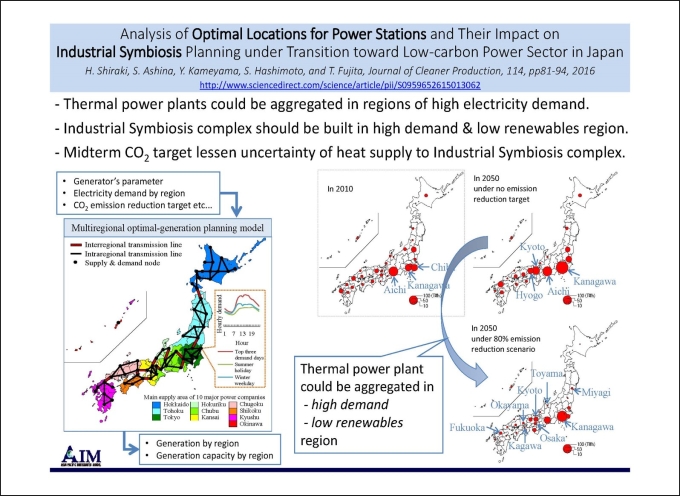Information of Paper
Authors:H. Shiraki, S. Ashina, Y. Kameyama, S. Hashimoto, and T. Fujita
Year:2016
Information of journal:Journal of Cleaner Production, 114, pp81‐94
◆link to the paper
Abstract
Power plants are one of key energy sources for industrial symbiosis complexes. However, decarbonization of the power sector, including decommissioning of existing fossil-fuel power plants, aggregation of power plant sites, and capacity augmentation of carbon-free power plants, is necessary to achieve low-carbon societies in the long term. Decarbonization results in declining advantage for industrial symbiosis complexes that rely on fossil-fuel power plants. To establish sustainable industrial symbiosis complexes, we used a quantitative model to analyze optimal locations and scales for power plants in Japan considering CO2 emissions reduction targets and several demand scenarios. Our results showed that even with a target of 80% CO2 emission reduction, almost half of Japan's electricity generation could come from fossil-fuel power plants in 2050 if CCS technology were deployed widely. Fossil-fuel power plants would be developed mainly in the regions of high electricity demand and little wind power potential, such as Tokyo, Chubu, and Kansai. From an intra-regional perspective, fossil-fuel power plants could be constructed in areas of high electricity demand. In addition, except for the above areas, generation from fossil-fuel power plants would vary in accordance with the availability of renewables and electricity demand. Our results indicate that future climate policy, regional electricity demand, and availability of regional renewables should be considered when planning the development of industrial symbiosis complexes.
*Click the figure to see larger picture





